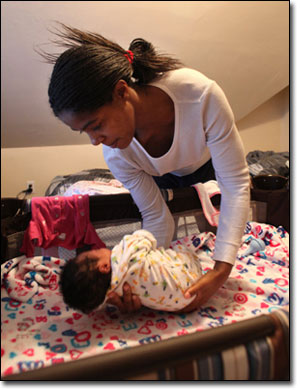This year, a team at the Milwaukee Journal Sentinel launched “Empty Cradles,” a yearlong reporting effort to find out why infant mortality is so high in the region and whether it must be that way. As we near the halfway point, their effort has already produced some powerful journalism and given new impetus to an issue that had been simmering, almost ignored, on the front burner all long.

Lakisha Stinson holds her daughter, Rashyia, in their Milwaukee home. Stinson’s first daughter, Kelviana, died of sudden infant death syndrome in 2004. Photo: Rick Wood/Milwaukee Journal Sentinel
In their latest major installment, in which they explore potential solutions to the crisis (and the recent lack thereof), reporters Crocker Stephenson and Ben Poston sum up the reason for their investigation in two damning paragraphs.
In Central Harlem, babies once died at a rate twice that of Milwaukee. But through a unified effort, the community has slashed its infant mortality rate by 78% since 1990. The rate there is now about 6 deaths per 1,000 births, lower than the state of Wisconsin as a whole.
In Milwaukee – where tens of millions of tax dollars have been spent in the past decade – 11 out of every 1,000 infants die before their first birthday. The city continues to have one of the worst infant mortality rates in the nation, especially for African-Americans, whose babies die at a rate about 2.5 times that of whites.
The problem, it seems, is that while the state supports 110 infant mortality reduction initiatives, they have so far failed to coalesce into a united public health effort.
Milwaukee and a few other urban areas are looking to change that, starting with the Lifecourse Initiative for Healthy Families which began in 2009. Modeled on successful programs in places like Harlem, the effort seeks to address the full spectrum of social factors that lurk behind high mortality rates.
In an earlier installment, reporters Mark Johnson and Tia Ghose looked at a medical mystery: African Americans in the United States are at a much higher risk than white Americans to have premature births, babies with low birth weights and infant mortality.
A married, college-educated African-American woman faces worse odds than a white, unmarried woman who dropped out of high school.
For more on how the series came together, see the background article editor Greg Borowski wrote for AHCJ this spring. It’s a great explanation of how to take a problem that everyone regards and common knowledge and report it into a deep, engaging, yearlong series. For more on previous installments in the series, see our coverage from January.




